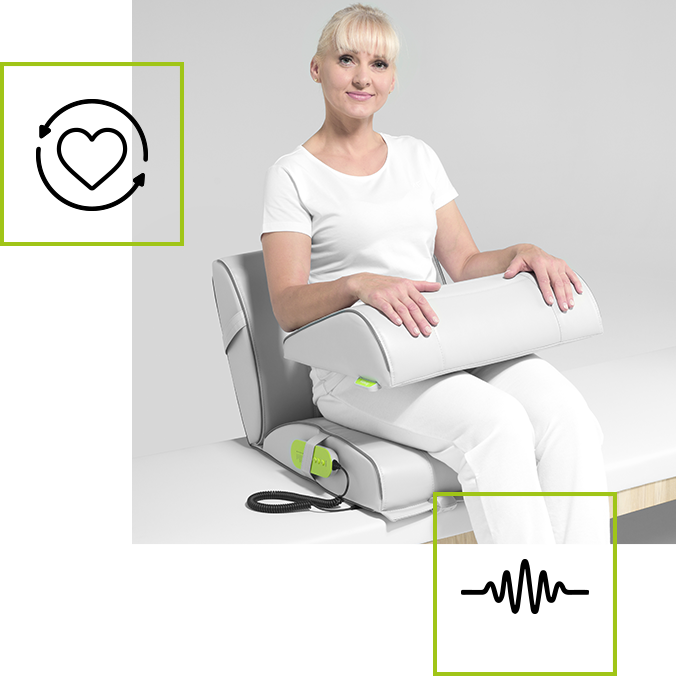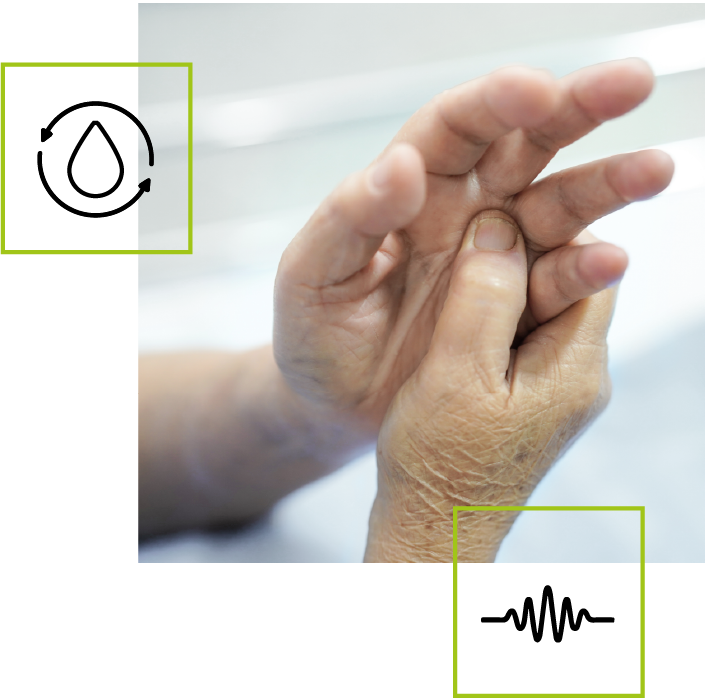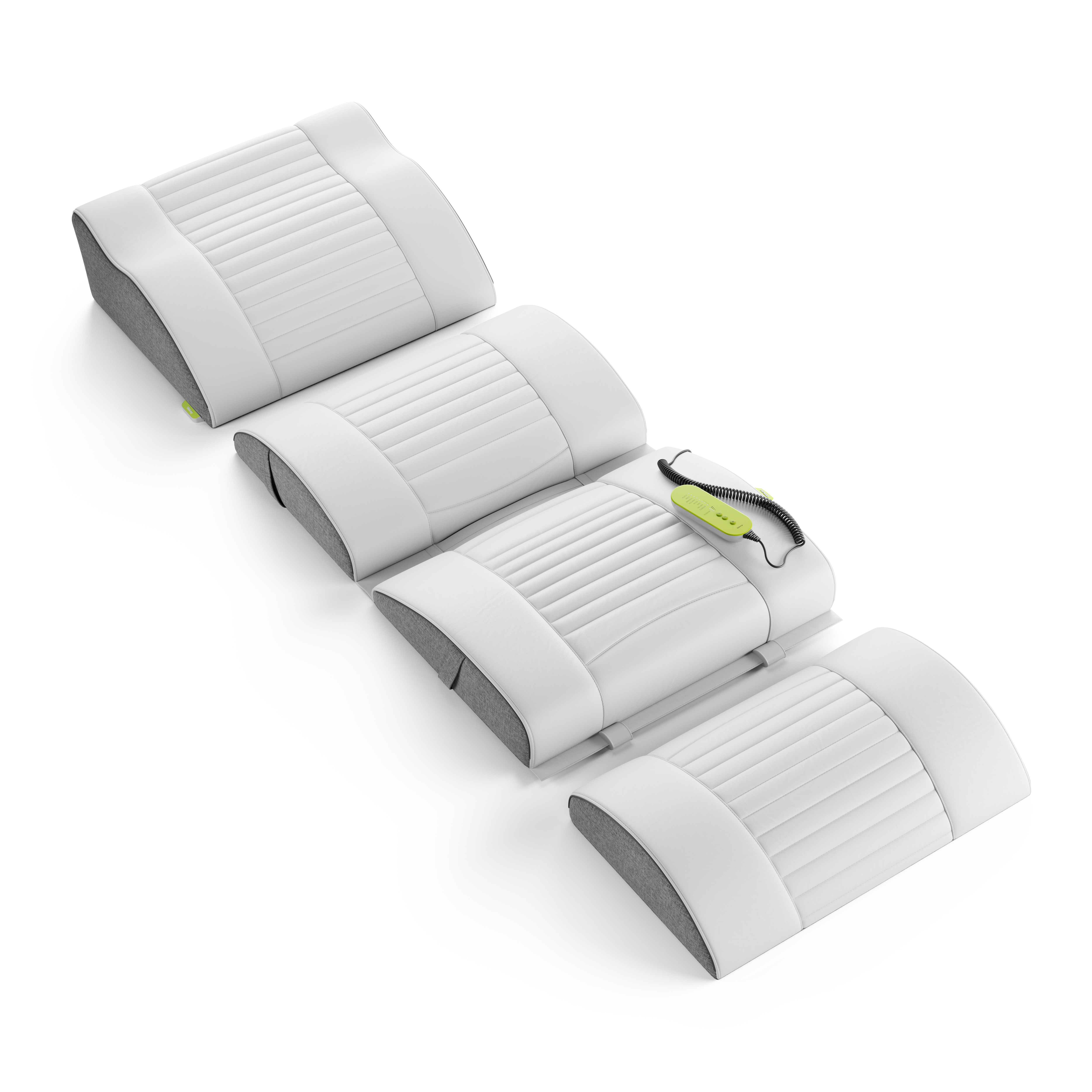Vibrotherapy - and hand numbness
Hand numbness is an ailment in which the patient experiences a tingling, burning sensation or loss of feeling in the hands, which can result from various causes such as nerve compression, circulatory disorders or degenerative changes in the spine. Vibration can provide an additional stimulus to stimulate nerves and improve blood circulation, which can promote regenerative processes and restore normal sensation in the hands.
How does it work?
In addition to activating and strengthening muscles, vibration can help improve muscle flexibility and increase blood flow in the hands area, which can affect overall muscle and tissue function. The Hands module uses vibration in the 10-40 Hz band, which has an analgesic effect, improves blood circulation, increases the range of mobility of individual joints, strengthens muscles and aids recovery from injury.


When and for whom?
Vibrotherapy is increasingly being recommended by doctors as a therapy to improve the functioning of people suffering from neuropathies and polyneuropathies, osteoarthritis, rheumatoid arthritis, carpal tunnel syndrome, as well as various sports or work-related injuries.
The Hands programme is recommended when you suffer from:
- Chronic degenerative problems or diseases of the hands (e.g. carpal tunnel syndrome, RA, psoriatic arthritis, finger flexor tendonitis, de Quervain's disease, Dupuytren's contracture)
- Hand pain
- Contractures and paresis (cerebral palsy, stroke, ataxia)
- Numbness, tingling in the hands
- Cold hands
- Tennis elbow
Performance
The eight-week vibration therapy significantly improves tactile perception, free movement and spasticity. It also increases the range of mobility of the fingers, elbow and arm.

Lee JS, Kim CY, Kim HD. Short-Term Effects of Whole-Body Vibration Combined with Task-Related Training on Upper Extremity Function, Spasticity, and Grip Strength in Subjects with Poststroke Hemiplegia: A Pilot Randomized Controlled Trial. Am J Phys Med Rehabil. 2016 Aug;95(8):608-17
Benefits of vibrotherapy

No side effects

Action confirmed
by scientists and practitioners

Perceptible effects
from 1 treatment

Long-lasting effects through systematic use
Hand numbness - causes
Hand numbness can have a variety of causes, some of the most common being:
- Carpal tunnel syndrome - compression of the median nerve in the wrist, resulting in tingling, pain and numbness in the fingers, especially the thumb, index finger and middle finger.
- Nerve compression - can result from prolonged pressure on the nerves in the hand or forearm caused, for example, by incorrect sleeping position, computer work or repetitive movements.
- Circulatory disorders - inadequate blood supply to the hands and fingers, e.g. due to cold, atherosclerotic lesions or diseases such as Raynaud's disease, can cause numbness and a cold feeling.
- Nerve damage - peripheral neuropathies, often associated with diabetes, can cause numbness and tingling not only in the hands but also in other parts of the body.
- Degeneration of the cervical spine - degenerative changes in the spine can lead to pressure on nerve roots, causing numbness, pain and weakness in the upper limbs.
- Vitamin deficiencies - lack of Bvitamins, especially B12, can lead to nerve damage and numbness in the limbs.
- Autoimmune diseases - certain diseases, such as multiple sclerosis or lupus, can cause numbness symptoms in various parts of the body, including the hands.
- Injuries - any injury, such as fractures or soft tissue damage around the hands, arms or neck, can lead to numbness in the hands.
- Other neurological causes - neurological conditions, such as a stroke or brain tumour, can also cause numbness in the hands as one of the symptoms.
Diagnosing the cause of hand numbness requires consultation with a doctor, who may order appropriate diagnostic tests.
Hand numbness and vibrotherapy
Vibrotherapy can be an effective adjunct therapy for hand numbness, especially if the cause is related to nerve, circulatory or muscle tension disorders. Thanks to the precise, safe vibrations that are transferred to the tissues, it is possible to:
1. stimulate the nervous system - vibration can improve nerve conduction, which can help restore normal sensation in the hands and reduce tingling and numbness.
2. Improving circulation - vibration increases blood and lymph flow in the tissues, which can promote nerve regeneration and increase the supply of oxygen and nutrients essential for nerve cell health.
3. reducing muscle tension - muscle tension, often present with postural disorders or stress, can put additional pressure on nerves. Vibrotherapy has a relaxing effect on the muscles, which can reduce pressure on the nerves and relieve numbness.
4. stimulation of the lymphatic system - improving lymph flow aids the removal of toxins and unnecessary metabolic products that can contribute to discomfort and feelings of numbness.
Vibrotherapy, as an adjunctive method, can be used regularly in conjunction with exercise and rehabilitation. It can provide relief from chronic numbness and improve the overall function of the upper limbs.
Hand numbness - treatment
Treatment of hand numbness depends on the cause of the symptom, and effective therapy can include a variety of approaches. Physiotherapy and exercises to strengthen muscles and stretch pressure areas can help reduce the discomfort. Physiotherapy also includes manual therapy, ultrasound or electrotherapy to relieve symptoms. Vibrotherapy, which involves the use of vibration, helps improve nerve conduction, circulation and reduce muscle tension, which can benefit the hands of numbness sufferers; regular treatments promote recovery and reduce discomfort.
Pharmacotherapy includes the use of painkillers, anti-inflammatory medications and B vitamins (especially B12) to support treatment of the causes of numbness. In cases of neuropathy, doctors may prescribe medications to improve nerve function. If the cause of the numbness is carpal tunnel syndrome, special wrist orthoses, used especially at night, can help. In advanced cases, surgery may be needed to decompress the median nerve.
It's also worth making lifestyle changes and improving work ergonomics - avoiding prolonged pressure on the hands and working in an ergonomic position can prevent symptoms from worsening. Regular breaks and stretching exercises during work are also recommended. Massage and acupuncture can be helpful in relieving muscle tension and improving blood flow, which provides relief from chronic numbness. For those whose numbness is caused by degenerative changes in the cervical spine, postural correction, strengthening of deep muscles and proper positioning during daily activities can be helpful.
In cases of difficult-to-treat or worsening symptoms, neurological consultation is necessary. A neurologist may order more advanced tests, such as EMG (electromyography), to assess nerve function. Selection of the appropriate treatment should be tailored individually to the patient, preferably under the guidance of a specialist, to achieve maximum therapeutic effects and alleviate the symptoms of hand numbness.


SKOT
developed by Vitberg

Modular design
and better positioning

General performance
and whole body effects of vibration
Pomożemy Ci dobrać moduły do Twoich indywidualnych potrzeb
- legs
- knees
- achilles
- achilles tendon
- achilles tendonitis
- exercise
- exercise
- post-exercise pain
- doms
- lower limbs
- swelling
- sports recovery
- overtraining
- spasticity
- spasticity
- varicose veins
- arms
- arthritis
- arthritis
- ra
- rheumatoid arthritis
- rheumatism
- back
- shoulder
- spine
- shoulder pain
- painful shoulder syndrome
- frozen shoulder
- neck pain
- cervical spine pain
- back pain
- sacroiliac pain
- radiculitis
- lumbar spine pain
- lumbar pain
- neuropathic pain
- neuropathies
- stroke
- neck
- pain relief
- stroke prevention
- torso neck
- insomnia
- leg pain
- restless legs syndrome (sns)
- sleep disturbances
- venlectasias
- difficult-to-heal wounds
- teleangiectasias
- sciatica
- rls
- wounds
- diabetic wounds
- circulation problems
- sleep problems
- spider veins
- ulcers
- lymphoedema
- non-healing wounds
- spastic paresis
- hemiparesis
- lower limb paresis
- paresis
- neuropathy
- neuralgia
- lumbago
- lymphatic
- lymph
- lymphatic drainage
- leg lymphatic drainage
- hip pain
- myocardial infarction
- anxiety
- hip osteoarthritis
- pain
- acute pain
- chronic pain
- heart disease
- heart
- pressure
- hypertension
- pressure spikes
- high blood pressure
- depression
- depressive state
- fibromyalgia
- concentration
- circulation
- lumbar
- lumbar
- cystic fibrosis
- hypertension
- copd
- post-mi
- rehabilitation
- post-stroke rehabilitation
- pulmonary rehabilitation
- cardiac rhythm
- saturation
- stress
- respiratory system
- pain management
- cardiovascular fitness
- shortness of breath
- clots
- hip degeneration
- veins
- prevention of myocardial infarction
- knee pain
- knee
- chondromalacia patella
- sports massage
- knee joint degeneration
- multiple sclerosis
- sports
- ms
- muscle strength
- patella
- balance
- muscle pain
- myalgia
- degeneration
- joint degeneration
- stomach
- elevated sugar levels
- metabolic problems
- fat
- body fat
- glucose
- insulin
- diabetes
- pre-diabetes
- metabolism
- paresis of upper limbs
- pain in the hands
- improved circulation in the hands
- condition after a hand fracture
- cerebral palsy
- raynaud's disease
- hand swelling
- carpal tunnel
- hand numbness
- hand spasticity
- upper limb spasticity
- cold hands
- parkinson's
- overweight
- obesity







